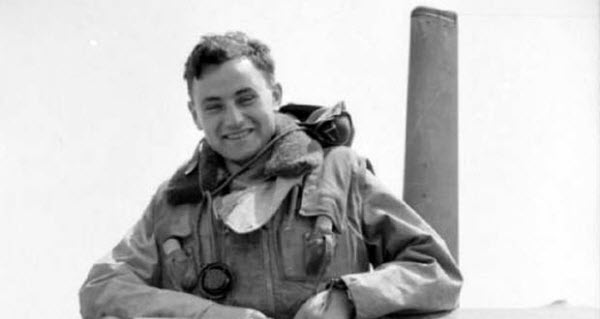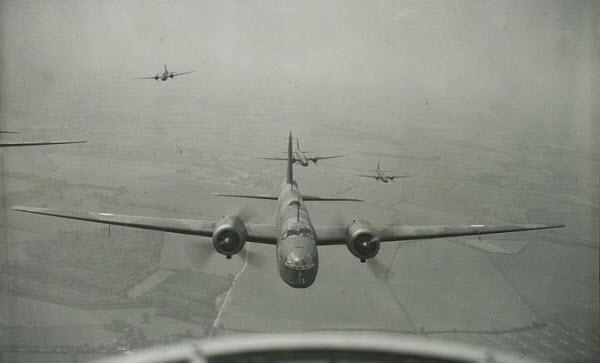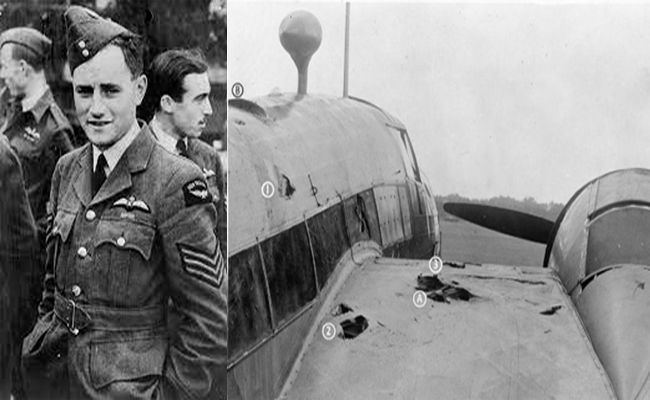If you were unfortunate enough to find yourself in a plane with a burning wing, you would probably think that jumping out with a parachute is the best option. If you also have a battalion of Nazis behind you, the situation gets even more complicated. For James Ward, the solution was clear: he needed to get out of the plane at 4,000 meters to fix it.
What happened on July 7, 1941, is considered one of the most incredible (and reckless) aerial feats performed by a man during a conflict. The blend of bravery and audacity (and possibly a touch of recklessness) displayed by the young soldier was a feat worthy of the best fiction.
Alongside Ward and the rest of the crew, the great protagonist of this story was the Vickers Wellington used for the mission in the context of World War II. This was a medium twin-engine bomber of the British forces, a long-range aircraft whose production began in the 1930s.
It was developed in response to the demand for a better-performing twin-engine day bomber. Thus, the Wellington became part of the night bombers during the early stages of World War II (later replaced by four-engine aircraft).

Regarding its design, which is crucial to understanding the upcoming story, Ward was aboard a Wellington Mark IC. This aircraft accommodated up to six crew members, with a length of just over 19 meters. Its maximum operational speed was 378 km/h, and it had a service ceiling of up to 5,490 meters. As for armament, the bomber was equipped with Browning M1919 machine guns of 7.7 mm caliber: 2 in the front turret, 2 in the tail turret, and 2 in the dorsal positions. Lastly, it could carry up to 2,000 kg of bombs.
The Victoria Cross is said to be the highest military decoration for valor “in the face of the enemy” among all British honors. It is awarded only for extraordinary acts that involve extreme risk to one’s own life.
If the details of each Victoria Cross awarded were already fascinating, James Ward’s was probably the most singular of all.
James, who said fear, Ward
James Allen Ward was born on June 14, 1919, in Wanganui, New Zealand, a city on the west coast of the North Island. He attended university there, trained as a teacher, and later taught at the Wellington College of Education in 1938. Two years later, in 1940, he enlisted in the Royal New Zealand Air Force and joined the pilot school in Wigram and Taieri.
Ward quickly distinguished himself for his piloting skills alongside his friend Fraser Barron. In January 1941, with World War II in full swing, they were assigned to Europe. Both pilots ended up stationed at Lossiemouth airbase in Scotland.
At that time, Ward was 22 years old and joined Squadron 75. Six months later, his life was about to take a dramatic turn. It happened on July 7, 1941.
By the end of the day, his name would be etched in history books.
That morning, the mission was clear. Aboard the Wellington Mark IC, they were to carry out a raid on the German city of Munster. Sergeant Ward would be the second pilot. According to historical reports, the mission went smoothly, the bomber dropped its bombs on the selected area, conducted a brief reconnaissance of the city, and began the return journey to base.
For the crew, it had been one of the simplest missions they remembered; they had encountered almost no opposition on the target, only some anti-aircraft fire and searchlights on the way back. Once the pilot set the course back, the soldiers relaxed.
As the second pilot, Ward was in the navigator’s small dome, responsible for monitoring the flight back for any approaching enemies. Suddenly, at the old entrance to the North Sea, in Zuiderzee (northwest of the Netherlands), Ward spotted a black shape growing larger and larger. Within seconds, he had no doubts.
A Messerschmitt Bf 110, a German Luftwaffe fighter with unfriendly intentions, was approaching from the rear of the bomber. Ward tried to communicate with the pilot via the internal radio, but it had stopped working. A few seconds later, before the sergeant could approach the pilot, the bomber was struck hard on one side as German bullets rained down.

The first reaction of the captain and squadron pilot was to violently dive the plane to try to escape the enemy fire. At that moment, no crew member realized that the tail gunner had already shot down the German fighter; once again, the fault lay with the internal radio failure that hindered communication between them.
After a few seconds of panic, it was time to reassess the situation. The attack, although brief, had been intense, causing significant damage to the aircraft. The starboard engine had been hit, and the hydraulic system was out of action. As a result, half of the landing gear had fallen off. In other words, there was no way to perform a “normal” landing. To make matters worse, the bomb doors were left open, and the tail gunner was injured in one foot after the exchange.
But undoubtedly the worst of all was the fire that had started across the upper surface of the starboard wing, where there was also a fuel leak. The plane could explode at any moment, and there was no time to lose. Given the situation, the logical thing would be to jump and use the parachutes. Instead, Ward and one of his comrades convinced the others to opt for a “Plan B.”
Both took the fire extinguisher and struck the side of the fuselage adjacent to the burning wing. They managed to make a hole through which Ward intended to reach the damaged area. The problem was that the fire was too far away, and it was quite a difficult maneuver even for a professional stunt performer; for Ward, it would be doubly difficult.
At that moment, the aircraft had reached the Dutch coast and was flying parallel, waiting to make a decision based on how the fire was developing. It seemed, although it was the crew’s assumption, that the fire was subsiding and remaining stable, so they decided it was better to risk ending up in a boat in the North Sea than to crash in a German prisoner-of-war camp. The bomber headed out to sea and made its way toward England.
A few minutes later, it appeared that the fire was intensifying again. Ward was the closest and best able to assess the situation. The pilot believed there was a real chance of reaching the fire by exiting from the small surveillance cabin where he was, then making his way along the side of the fuselage and finally reaching the damaged wing area.
Joe, the pilot, thought it was madness, but there was a rope. Ward thought that if it was tied to him, the rope would be long enough to keep him connected to the bomber while he was outside. Thus, they ended up tying the rope to the pilot’s chest, and Ward began his heroic attempt to extinguish the fire on the wing at an altitude of 4,000 meters. As a last resort, if the plan went wrong, Ward had his parachute on.

And so it was done. The man climbed out and then sat on the edge of the cockpit dome with his legs still inside, calculating how he would execute such a plan. After a few brief seconds, Ward took an emergency axe, placed one foot outside, then extended his leg, followed by his hand with the axe… and struck the external fabric of the fuselage, creating a small hole to insert his foot into the aircraft’s frame.
After this first move, he made several similar moves, all aimed at getting his hands and feet closer to the damaged wing area via this improvised path along the side of the fuselage. All this, remember, while the man was being held somewhat acrobatically with a rope to avoid being thrown off.
Once outside, the man approached very slowly while holding on to the holes he had created. His comrade kept the rope taut to prevent him from falling. The fire blazed like a large jet of gas, flying very close to Ward’s shoulder. The sergeant had only one hand to work with while barely holding onto the aircraft with the other. The force of the wind caused him to nearly be thrown off several times. The scene, dramatic and cinematic, had Ward lying as flat as possible on the wing. Moreover, the parachute made movement difficult, and the wind buffeted him, lifting him slightly.
That said, the worst was yet to come. The gusts of wind grew more violent, and Ward began to be battered by the wing. The engine’s airflow worsened the situation. It was like being in a terrible gale, only this gale was accompanied by fire several thousand meters above the ground.
Eventually, Ward reached the fire and, with the cloth he used to cover the engines, began a desperate attempt to extinguish it. A few minutes later, he succeeded, though with a great scare. The cloth he was using to put out the fire inflated with a gust of wind and almost carried him away. James Ward had achieved the impossible, and although the tank continued to leak fuel, they calculated they would have enough to make it home. Additionally, Ward had removed all the nearby fabric to prevent the fire from spreading from the fuel intake.
Slowly, Ward returned from the wing and managed to crawl back to the top of the fuselage, the previous step to climbing back into the small surveillance dome from which he had started. Shortly after, the Wellington reached the English coast, and the wing caught fire again, but this time with enough time to land and successfully complete a historically significant mission.
Ward ultimately received the prestigious Victoria Cross. In August of that same year, he was summoned to 10 Downing Street by Prime Minister Winston Churchill. Ward turned out to be incredibly shy and was left speechless in the presence of the historic figure.
It is said that Churchill himself had to approach and say to the young man, “I feel this is a very awkward situation for you, and that you probably feel embarrassed in my presence.” To which Ward responded with his head down, “Yes, sir.” “Well, imagine how humble and clumsy I feel next to you,” replied Churchill.
Unfortunately for the man who was capable of climbing onto the burning wing of a bomber damaged by the Nazis (and at over 4,000 meters altitude), death awaited him a few weeks later. On September 15, 1941, the Wellington Ward was in was hit by German anti-aircraft artillery. Ward died in the crash.
It was the pilot’s eleventh mission, his fifth as captain of the crew.
